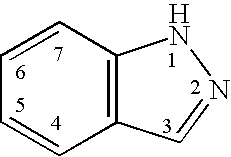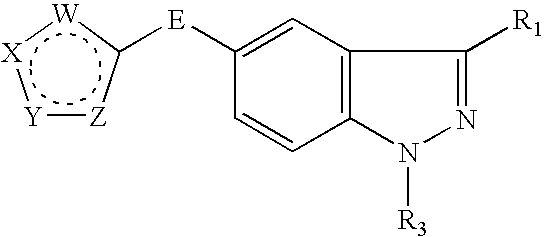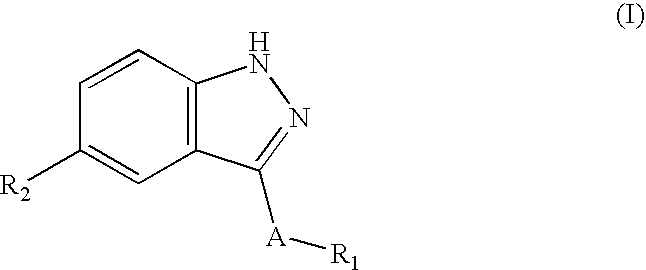Methods for treating, preventing and managing chronic lymphocytic leukemia with indazole compounds
a technology of indazole and compounds, applied in the field of indazole compounds, can solve the problems of tumor cell growth, disrupted angiogenesis, and jnk inhibitors may block transformation, and achieve the effect of modulating the level of cellular rna and dna synthesis, and being useful in treatmen
- Summary
- Abstract
- Description
- Claims
- Application Information
AI Technical Summary
Benefits of technology
Problems solved by technology
Method used
Image
Examples
example 1
SYNTHESIS OF 3-(4-METHOXYPHENYL)-1H-INDAZOLE
[0208]
A. 3-Bromo-1H-indazole
[0209] To a suspension of 1H-indazole (3.00 g, 25.4 mmol) in 2.0 M sodium hydroxide solution (70 mL) at ambient temperature was added a solution of bromine (3.00 g, 18.8 mmol) in 2.0 M sodium hydroxide solution (30 mL) dropwise. After stirring for 3 hours, to the reaction mixture was added sodium bisulfite (0.1 g), followed by 2.0 N hydrochloric acid solution (80 mL). The precipitates were filtered and washed with water to provide the title compound (3.98 g, 80% yield): mp 136° C.; 1H NMR (CDCl3) δ 13.4 (br s, 1H), 7.57 (m, 2H), 7.45 (t, 1H), 7.22 (t, 1H); EI-MS (m / z) 198 [M+2]+, 196 [M]+.
B. 3-(4-Methoxyphenyl)-1H-indazole
[0210] A mixture of 3-bromo-1H-indazole (0.20 g, 1.0 mmol), 4-methoxyphenylboronic acid (0.228 g, 1.5 mmol), and tetrakis(triphenylphosphine) palladium(0) (0.228 g, 0.1 mmol) in ethylene glycol dimethyl ether (5 mL) and 2.0 M sodium carbonate solution (6 mL) under nitrogen was heated at 100...
example 2
SYNTHESIS OF 3-(4-HYDROXYPHENYL)-1H-INDAZOLE
[0211]
A. 3-Bromo-1-[2-(methoxyethoxy)methyl]-1H-indazole
[0212] To a solution of 3-bromo-1H-indazole (6.15 g, 31 mmol) in dried tetrahydrofuran (40 mL) at ambient temperature was added 1.0 M solution of sodium bis(trimethylsilyl)amide in tetrahydrofuran. After stirring 20 minutes, to the mixture was added neat 2-methoxyethoxymethyl chloride (4.36 g, 35 mmol). The reaction mixture was stirred at ambient temperature overnight. It was quenched with water and extracted with chloroform. The extracts were dried over magnesium sulfate, filtered, and concentrated. The residue was then purified by chromatography (SiO2, 15-30% ethyl acetate / hexane) to provide the title compound (6.512 g, 74% yield): EI-MS (m / z) 286 [M+2]+, 284 [M]+.
B. 1-[2-(Methoxyethoxy)methyl]-3(4-methoxyphenyl)-1H-indazole
[0213] A mixture of 3-bromo-1-[2-(methoxyethoxy)methyl]-1H-indazole (0.640 g, 2.2 mmol). 4-methoxyphenylboronic acid (0.456 g, 3.0 mmol), potassium phosphate...
example 3
SYNTHESIS OF 3-(2-METHOXYPHENYL)-1H-INDAZOLE
[0215]
A. 1-[2-(Methoxyethoxy)methyl]-3-(2-methoxyphenyl)-1H-indazole
[0216] The title compound was prepared as described in Example 2 B, using 2-methoxyphenylboronic acid (0.304 g, 2.0 mmol) (0.235 g, 48% yield): 1H NMR (CDCl3) δ 7.74 (d, 1H), 7.49 (m, 3H), 7.32 (t, 1H), 7.04-7.15 (m, 3H), 5.73 (s, 2H), 3.78 (s, 3H), 3.65 (m, 2H), 3.41 (m, 2H), 3.29 (s, 3H); EI-MS (m / z) 312 [M]+.
B. 3-(2-Methoxyphenyl)-1H-indazole
[0217] A solution of 1-[2-(methoxyethoxy)methyl]-3-(2-methoxyphenyl)-1H-indazole (0.20 g, 0.64 mmol) in 1,4-dioxane (4 mL) and 6 N hydrochloric acid solution (4 mL) was stirred at ambient temperature for 16 hours. It was neutralized with saturated sodium carbonate solution and extracted with chloroform. The extracts were dried over magnesium sulfate, filtered, and concentrated. The residue was then purified by chromatography (SiO2, 20-40% ethyl acetate / hexane) to provide the title compound (0.061 g, 60% yield): mp 99° C.; 1H NMR...
PUM
 Login to View More
Login to View More Abstract
Description
Claims
Application Information
 Login to View More
Login to View More - R&D
- Intellectual Property
- Life Sciences
- Materials
- Tech Scout
- Unparalleled Data Quality
- Higher Quality Content
- 60% Fewer Hallucinations
Browse by: Latest US Patents, China's latest patents, Technical Efficacy Thesaurus, Application Domain, Technology Topic, Popular Technical Reports.
© 2025 PatSnap. All rights reserved.Legal|Privacy policy|Modern Slavery Act Transparency Statement|Sitemap|About US| Contact US: help@patsnap.com



